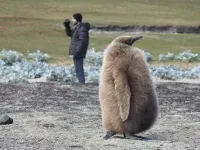(Press-News.org) Opioids are the main driver of fatal drug overdoses in the United States, according to the Centers for Disease Control and Prevention, resulting in 46,802 deaths in 2018, usually because the person stops breathing.
Naloxone -- a Food and Drug Administration-approved medication used to reverse overdoses from opioids, such as heroin, morphine and oxycodone -- works by restoring normal respiration to a person whose breathing has slowed or stopped.
"Opioid overdoses cause the largest number of accidental and avoidable deaths," said Peter Davidson, PhD, associate professor in the Department of Medicine at University of California San Diego School of Medicine. "The human toll of drug addiction is devastating. Using naloxone to prevent opiate overdoses can and has saved many lives."
In a study published in the March 23, 2021 online edition of the International Journal of Drug Policy, Davidson and an international group of researchers, found that opioid users who participate in a 12-step abstinence program and recently stopped using drugs refused to take home naloxone, even if having it on hand might save lives.
For the study, trained interviewers visited areas known for high drug use in three Southern California counties: San Diego, Orange and Ventura. Forty-four participants were asked questions about drug use initiation, overdose experiences, both their own and observed and past treatments.
"In our research, individuals who were newly abstinent from opioid use believed that carrying naloxone symbolically tied them to a drug-use identity that they were trying to leave behind," said first author Jeanette Bowles, DrPH, who is now a postdoctoral fellow with the Centre on Drug Policy Evaluation in Toronto, Canada, but was a UC San Diego School of Medicine postdoctoral fellow at the time of the study.
"Twelve-step programs promote abstinence through social behaviors that include staying away from people, places and things considered to be tied to drug use. Naloxone was seen as an item linked to their drug use and clashing with these sober behaviors and their goal of abstinence."
To reduce the stigma associated with naloxone, researchers suggest reframing the meaning of carrying naloxone to represent a commitment to group safety and the wellbeing of those "who still suffer" and relabeling naloxone training programs in substance use disorder treatment settings as "overdose first aid."
In addition, researchers propose focusing on the lifesaving impact those trained to administer naloxone can have on their peers, and re-targeting naloxone distribution efforts to include persons at any phase of their drug use, including abstinence.
"It is very important that people understand that after periods of abstinence, the body is less tolerant if an individual resumes drug use, making them physiologically more vulnerable to overdose and death," said Davidson, co-corresponding author and principal investigator. "If someone is experiencing an opioid overdose, it is important to recognize the signs and respond quickly to prevent death."
In the United States, laws now allow people to access and use naloxone to respond to overdose with protection from liability.
The Addiction Recovery and Treatment Program at UC San Diego Health provides patients with outpatient behavioral treatment for substance use, such as cannabis, alcohol and opioids.
INFORMATION:
Co-authors include: L.R. Smith, M.L. Mittal, E. Copulsky, and G. Hennessy, all of UC San Diego; R.W. Harding and K.D. Wagner, University of Nevada, Reno; and A. Dunkle, Solace Foundation.
A major goal of organic and medicinal chemistry in recent decades has been the rapid synthesis of three-dimensional molecules for the development of new drugs. These drug candidates exhibit a variety of improved properties compared to predominantly flat molecular structures, which are reflected in clinical trials by higher efficacy and success rates. However, they could only be produced at great expense or not at all using previous methods. Chemists led by Prof. Frank Glorius (University of Münster, Germany) and his colleagues Prof. M. Kevin Brown (Indiana University Bloomington) and Prof. Kendall N. Houk (University of California, Los Angeles) have now succeeded in converting several classes of flat ...
Skoltech scientists and their colleagues have proposed a new human height inheritance model that accounts for the interaction between various factors that influence adult human height. The research was published in the European Journal of Human Genetics.
Human height is a classical quantitative trait that depends on sex, genetics, and the environment.
Scientists from Skoltech, Novosibirsk State University, the Institute of Cytology and Genetics of the Siberian Branch of RAS, and the Institute of Science and Technology in Vienna analyzed the human height distribution ...
Buried beneath 20 kilometers of ice, the subsurface ocean of Enceladus--one of Saturn's moons--appears to be churning with currents akin to those on Earth.
The theory, derived from the shape of Enceladus's ice shell, challenges the current thinking that the moon's global ocean is homogenous, apart from some vertical mixing driven by the warmth of the moon's core.
Enceladus, a tiny frozen ball about 500 kilometers in diameter (about 1/7th the diameter of Earth's moon), is the sixth largest moon of Saturn. Despite its small size, Enceladus attracted the ...
About two decades after first devising a new kind of vaccine, Oregon Health & Science University researchers are unlocking why it stops and ultimately clears the monkey form of HIV, called SIV, in about half of nonhuman primates - and why it's a promising candidate to stop HIV in people.
In scientific papers that were simultaneously published today in the journals Science and Science Immunology, creators of the cytomegalovirus, or CMV, vaccine platform describe the unusual biological mechanisms through which it works.
The findings also helped fine-tune VIR-1111, the CMV-based experimental vaccine against HIV that was developed at OHSU and is now being evaluated in a Phase 1 clinical trial. The trial is being conducted by Vir Biotechnology, which ...
SILVER SPRING, Md. - As concern has grown over COVID-19 variants and their implications for how well COVID-19 vaccines will protect against the virus, researchers have proposed a method to examine instances of SARS-COV-2 infections in people who have received a COVID-19 vaccine.
Genomic sieve analysis of these so-called "breakthrough" SARS-CoV-2 infections in COVID vaccine trials is a critical tool to identify viral mutations associated with vaccine failure and to predict how vaccination impacts the virus' evolution.
Dr. Morgane Rolland, Chief of Viral Genetics ...
Scientists at Sinai Health say they have discovered a new pathway that controls dangerous overreactions in a body's immune system, including deadly forms of hyper-inflammation.
In new findings out today in the journal Science, researchers at the Lunenfeld-Tanenbaum Research Institute (LTRI) detail how a protein known as WAVE2, a protein expressed in all immune cells, plays a critical role in maintaining immune system balance.
As part of the research, scientists knocked out, or turned off, WAVE2 in a subset of immune cells in mice, which led to severe autoimmunity and inflammation, ...
Despite having remarkable utility in treating movement disorders such as Parkinson's disease, deep brain stimulation (DBS) has confounded researchers, with a general lack of understanding of why it works at some frequencies and does not at others. Now a University of Houston biomedical engineer is presenting evidence in Nature Communications Biology that electrical stimulation of the brain at higher frequencies (>100Hz) induces resonating waveforms which can successfully recalibrate dysfunctional circuits causing movement symptoms.
"We investigated the modulations in local ?eld potentials induced by electrical stimulation of the subthalamic nucleus (STN) at therapeutic ...
Tel-Aviv, ISRAEL - March 25, 2021 - Wild Biotech, a preclinical stage drug discovery & development company emerging out of stealth mode, today announces the publication of its first major paper, which appears in the journal Science. The study mapped the gut microbiota of animals in the wild on an unprecedented scale, adding millions of potentially novel microbiome-based therapeutics for human diseases to the company's already massive database. Wild will use these findings to first tap its database for targets in inflammatory, immune and gastrointestinal diseases.
"For the study, we collected gut microbiota from almost 200 species of animals in the wild, covering diverse classes, feeding behaviors, geographies, and ...
Water scarcity in rural Alaska is not a new problem, but the situation is getting worse with climate change. Lasting solutions must encourage the use of alternative water supplies like rainwater catchment and grey water recycling. They must also address the affordability of water related to household income, say researchers from McGill University.
Washing hands with clean water is something most people take for granted, yet for Alaska's rural residents, this is often not the case. When people pay for water by the gallon, serious thought is given to how much is used - even during the COVID-19 pandemic.
In many rural Alaskan communities, where jobs are scarce and household income is low, the cost of water is a high burden, according to the study published in Environmental ...
A medical device that has been shown to manage pain among babies born preterm can also help keep their brain oxygen levels steady during medical procedures, finds new analysis by researchers at UBC.
The device, called Calmer, is a pillow-sized therapeutic bed covered in soft fabric and inserted into the incubator. It can be programmed to mimic a parent's heartbeat and breathing rate-- providing a soothing presence by moving up and down gently to simulate a breathing motion and heartbeat sound for the baby when their parent cannot be present.
"For newborns and particularly for preterm babies, it's critical to keep overall blood oxygen levels steady, especially in the brain. The more stable their brain oxygenation is, the better for their brain development," ...





